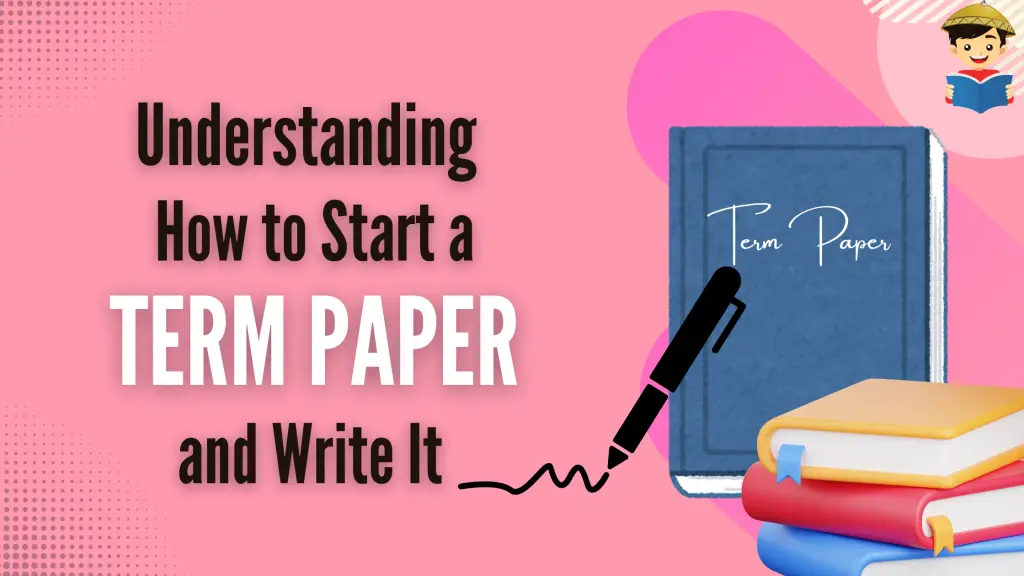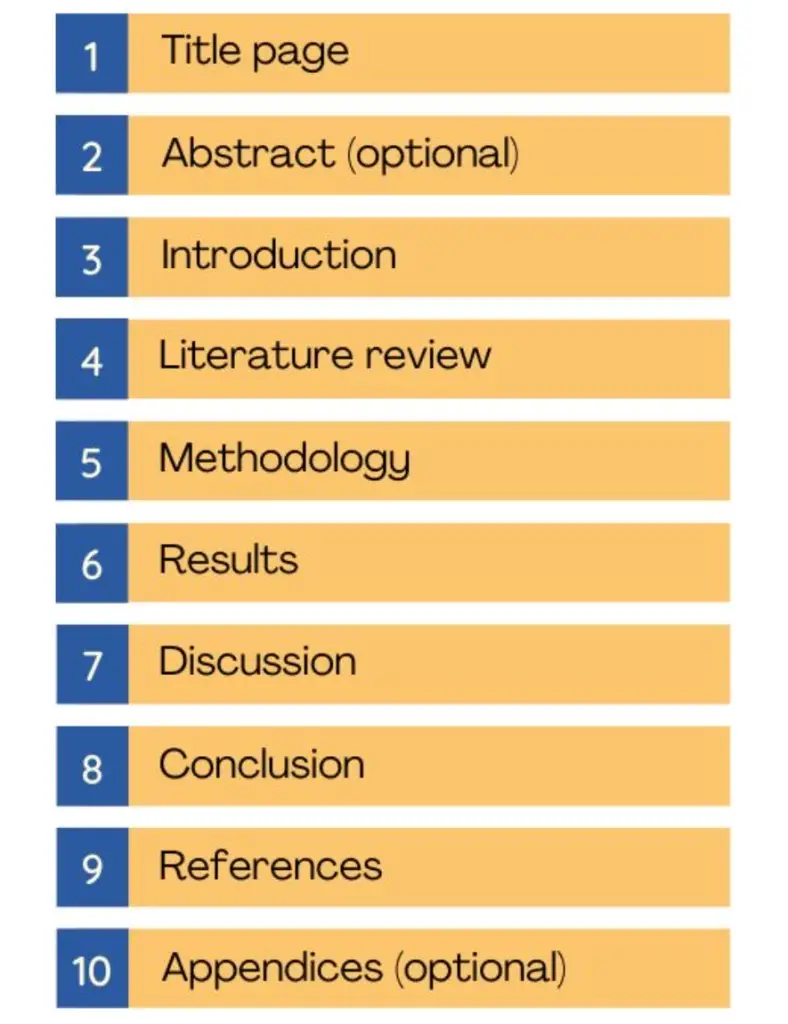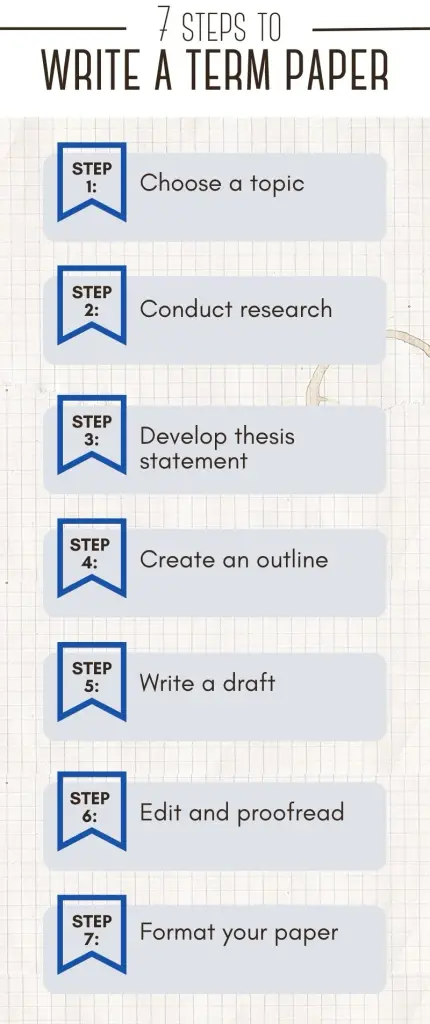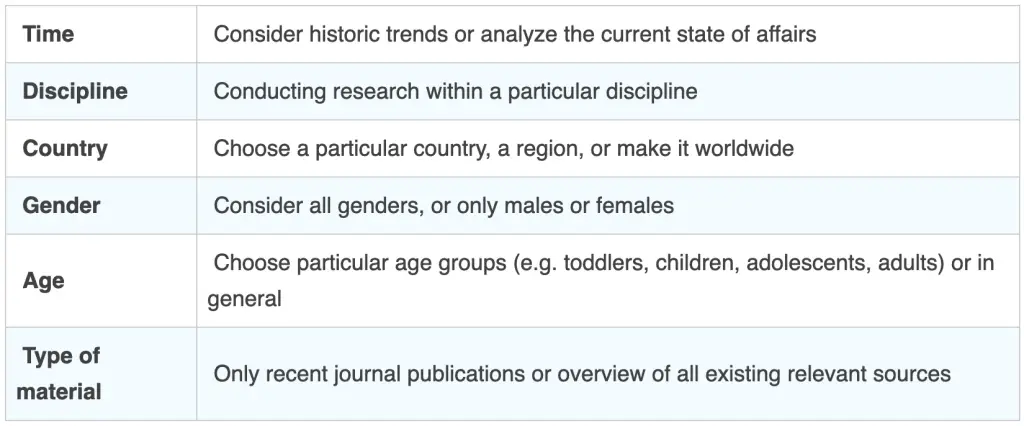Understanding How to Start a Term Paper and Write It

Tackling a term paper is no small feat, and it’s essential to recognize the challenges from the start. Academic assignments, including term papers, can often be stressful and may raise concerns about who can help with the writing process. Remember that there is a learning curve, and it’s normal not to be fully satisfied with your initial attempt.
The article “Understanding How to Start a Term Paper and Write It” provides valuable guidance and comprehensive advice on crafting an effective term paper. It also clarifies the standard structure of term papers and includes a sample section for reference, making the writing process clearer and more approachable.
Table of Contents
Definition of Term Paper
A term paper is a form of academic writing that may resemble a report or a research paper. It is usually assigned across schools, colleges, and universities at the end of an academic term. This paper significantly influences the overall grade for the course. While some students might be tempted to write my paper services, it’s important to understand the ethical implications and potential consequences of such actions.
Different courses have different requirements for term papers. Here, we present a generalized strategy and key components essential for writing one.
Standard Format of a Term Paper
Before starting a term paper and choosing a topic, it’s important to understand its basic format. The structure is key—it helps readers follow the content easily and keeps the writer focused, avoiding unnecessary details. Here’s a breakdown of the typical parts of a term paper:
Title Page: It should include the paper’s title, the student’s name, course name and code, the instructor’s name, and the submission date.
Abstract (optional): The abstract provides a brief overview of the central themes, theoretical frameworks, and key findings that will be discussed in the paper.
Table of Contents: This section is essential for facilitating smooth navigation through the document. It generally lists each section’s headings along with their corresponding page numbers.
Introduction: This initial paragraph introduces the reader to the paper’s basic premises, setting the stage for the discussion that follows.
Main Sections: Given the diversity of topics a term paper might cover, this segment could include multiple subsections. These should be arranged logically to ensure a coherent flow of ideas.
Conclusion: The conclusion serves as the capstone of the paper, synthesizing the main points and reaffirming the essential findings and their relevance to the topic at hand.
References: This section catalogs all the sources referred to or cited in the document, arranged alphabetically.
Appendix (optional): The appendix contains material that, while pertinent, would interrupt the flow of the main text. This often includes extensive data sets, detailed questionnaires, images, and supplementary materials.
Additionally, you may include a list of figures, tables, or abbreviations as necessary. Some term papers contain extensive supplementary information unsuitable for inclusion in the main text but can be appended after the references.
Structure of a Term Paper
This structure provides a framework for assembling a well-organized term paper. Once you understand these basic elements, you can adapt them to best suit the specific requirements of your term paper.

Before You Write a Term Paper
To produce a noteworthy term paper, thorough preparation is crucial. Since term papers generally exceed the length of essays, a detailed outline is advisable before you begin writing.
Read the assignment carefully. Understanding what your instructor expects from the term paper is vital. Start by meticulously reviewing the assignment instructions, as any experienced essay writer would, to ensure your approach aligns with the expected outcomes.
- Identify key terms. Familiarize yourself with common instructional verbs such as analyze, comment, compare, describe, discuss, etc. These are often crucial in understanding the scope and approach required for your assignments.
- Restate the assignment requirements. It’s easy to overlook key details when skimming through the instructions. To ensure everything is noticed, rewrite the requirements in your own words, maintaining the original intent. Alternatively, print out the assignment guidelines and keep them visible as a constant reference while you work.
- List essential questions. Compile a list of questions your paper needs to address based on your assignment. This will guide your research and ensure your paper is comprehensive and focused.
Engage in thorough research. Aim to gather a specific amount of information relevant to your topic. Employ skills like active reading, effective note-taking, and critical thinking throughout this process.
- Analyze existing information. As you review the literature, focus on understanding the main arguments of each source and how these are supported. Determine which sources will form the foundation of your paper.
- Take notes. Make detailed notes as you read, highlighting key information and direct quotes. Remember to note the sources of these insights.
- Use organizational tools. Mind mapping, charts, diagrams, and clustering can help you organize your thoughts and central points in a coherent structure.
Draft an outline. With the researched information, draft a structured outline of your paper. Assign titles to each section and consider adding topic sentences to streamline the subsequent writing phase.
Plan your schedule. Break down the writing process into manageable stages and schedule these on a calendar. Remember that writing a quality term paper is a process that cannot be rushed and typically requires more than a single night. You may create a physical copy of this schedule or save it digitally for easy access and tracking.
Selecting Sources for a Term Paper
Just as a builder understands the importance of a robust foundation for a building, the same principle applies to academic writing. A solid paper is built on the bedrock of reliable sources. Without them, your paper may be weak, compelling you to seek professional term paper writing services.
You’ll encounter many sources on your topic when searching for information, whether online or in a library. To sift through these effectively, consider yourself a detective searching for the truth within the texts.
Here’s how you can critically evaluate each source:
- Design and Layout: Assess the professionalism of the source’s presentation.
- Publication Date: Ensure the information is up-to-date and relevant to your current study.
- Authorship: Identifying the author should be straightforward. Reflect on the author’s credentials and their expertise in the field.
- Objectivity: The purpose of the source should be educational or professional. Avoid sources that appear promotional or sales-oriented.
- Writing Quality: Grammatical errors or typos often require more reliability.
- Content Volume and Quality: Evaluate the depth and breadth of the information. Consider if it includes graphs, statistics, and a comprehensive reference list. The presence of broken or missing links might indicate a less credible source.
- Relevance to Your Topic: Determine if the source aligns well with your research topic’s scope and requirements.
- Reputation and Bias: Verify the impartiality of the source. Utilize fact-checking sites that reference authoritative and credible sources.
Pro Tip: Early in your research, reading general texts from reputable journals and articles can help refine your thoughts and determine the direction of your argument in your paper. This preliminary reading is essential for framing the context of your research and identifying key points to explore.
| Recommended Sources | Sources to Avoid |
| Educational and Scientific Sources: Look for information rooted in scientific articles and publications, typically found on educational domains (.edu). Government Resources: Utilize statistical data and official research findings from government websites (.gov). Open Educational Resources: Access freely available educational materials on organizational sites (.org). Academic Publications: Refer to scientific books, journals, textbooks, and conference recordings for credible information. | Wikipedia: While a popular resource, it can be edited by anyone, which may affect reliability. YouTube: Video content is not typically suitable for academic citation unless verified by credible sources. Personal Blogs: These often contain personal opinions rather than researched facts. Certain News Outlets: For example, Fox News and similar platforms may not always provide the objectivity needed for academic research. Commercial Websites: Websites with a “.com” domain often prioritize commercial interests and may not provide scholarly content. |
Pro Tip: Search engines often tailor search results based on your past browsing history, known as a “filter bubble.” To avoid biased searches, clear your browser history and cookies and switch to incognito mode to access a broader range of information.
When you’ve gathered sufficient data, enhance your outline. This involves expanding your preliminary outline by integrating new findings, facts, examples, quotes, or expert opinions. Consider how these additions fit into different sections of your paper.
Crafting the Initial Draft of a Term Paper
So, how to start a term paper? This process can be approached in various ways, but preparation is key. Ensure you have a definitive purpose, a strong thesis statement, ample background information, and a detailed plan. If you struggle with selecting a topic, consider using tools like essay title generators to spark more ideas.
1. Writing the Abstract:
This initial section should outline the essence of your research. Write the abstract after completing the rest of the paper to summarize the significant findings better and make it understandable even to those unfamiliar with the subject. Aim for clarity and conciseness in your presentation.
Components of an effective abstract:
- Introduction. Begin by stating the research problem your paper addresses. Clarify the topic’s significance, discussing its practical, scientific, or theoretical relevance.
- Body. Outline the key aspects of your research, including the investigative approach adopted. Detail the nature of your findings.
- Conclusion. Discuss the implications of your results and how they can be applied.
To craft an abstract, revisit your paper to pinpoint pivotal statements that reflect the research objectives, methods, results, and conclusions. Extract these key sentences to form the initial draft of your abstract.
Pro Tip: Typically, an abstract should be between 120 and 250 words, though the exact length may vary according to specific assignment guidelines.
What differs abstract from introduction? The abstract is a concise summary of your paper, highlighting the main findings and conclusions, serving as a snapshot of the research. In contrast, the introduction sets the stage by providing necessary background information, articulating the thesis statement, and outlining the central issues that will be explored throughout the paper.
2. Writing the Introduction:
A compelling introduction can significantly enhance the reader’s interest. Consider how to effectively “sell” your paper:
- Capture attention. Start with a compelling hook—be it an intriguing fact, a startling statement, a paradox, or an argument emphasizing the topic’s significance.
- Set the scene. Provide a concise overview of the issue at hand and articulate the objectives of the paper. It’s also crucial to contextualize the topic within a broader framework.
- Write a thesis statement. Clearly state your paper’s central argument or primary question without explicitly announcing your intentions.
The introduction should only offer a broad view of the term paper, laying the groundwork without delving into detailed examples, quotations, or extensive information.
Pro Tip: Avoid mundane or overly general openings. Engage swiftly with the core of the topic to draw the reader further into the discussion.
3. Crafting the Body Sections:
After gathering your research findings and notes, examine what you’ve collected. Document the results of your research and eliminate any extra material.
Draft topic sentences based on your outline to begin crafting the body of your paper. Expand these topic sentences into complete sentences and enhance them with detailed support.
The extent of the body sections will vary depending on the topic and the specific requirements of the assignment. Typically, the body of a term paper includes a literature review and the research presentation itself.
Pro Tip: Start each paragraph with a clear topic sentence that introduces the main idea of that paragraph.
How to write a literature review? In the literature review, analyze the research you’ve uncovered related to your topic. Discuss the materials you’ve found and how they relate to your research context. Summarize the arguments and theories from various authors that you find credible while pointing out any gaps or overlooked elements in their research.
Term paper guidelines for writing body sections:
- Structure. Ensure the text is well-organized and divided into clear sections or subsections, each labeled with a title that reflects its main idea or point.
- Argument development. Introduce your arguments progressively, moving from broad generalizations to more specific details.
- Citation and evidence. A robust academic text requires solid evidence. Make sure to reference all quotations, ideas, and data according to the appropriate academic formatting style.
- Emphasize key points. Depending on your assignment’s guidelines and objectives, prioritize analysis of primary and secondary sources, current research issues, and your personal perspectives.
- Beyond summaries. Avoid mere summaries of the information found. Use citations to substantiate your viewpoints and argue your position on the topic.
- Balance of sources and originality. While it’s essential to base your arguments on credible sources, your paper should reflect your unique insights. Maintain a balance between sourced material and your original contributions.
- Paragraph length. Manage the length of your body paragraphs to keep them readable. If a paragraph becomes too lengthy, consider splitting it into smaller subsections for better clarity and flow.
4. Crafting the Conclusion:
As you conclude the main sections of your term paper, it’s essential to summarize the information gathered and discuss the implications of your findings. Keep these aspects in mind for your conclusion:
- Reiterate the key points made in the body sections and reaffirm your thesis statement.
Important: Remember, this section should refrain from introducing new information.
- Outline the final outcomes of your research, highlighting the conclusions you’ve drawn.
- Discuss the potential implications of your research for future studies. Consider questions like:
How might my findings be evaluated further?
What significance does my research hold?
Are there intersections between my topic and other areas?
- End with a strong closing sentence that encapsulates the significance of your research.
For instance: “While forgiveness therapy is still in its nascent stages within psychology and requires more empirical testing, it holds substantial promise for treating a variety of psychological disorders.”
Refining and Enhancing the Initial Draft
If you have completed your first draft and still have time, it’s essential to proofread your work. Revisiting the term paper is crucial, as many professors view misspellings, punctuation, and grammar mistakes as a lack of diligence. These errors can overshadow your original thoughts and important findings. So, how can you enhance the appearance of your text?
First, carefully read through your initial draft to see how you might refine and strengthen your paper. Identify any ideas that are out of place or need modification. Determine which arguments require more robust backing. Introduce transitional phrases to weave your ideas together more cohesively.
Second, once you ensure that the content is logical and well-organized, proceed to the proofreading stage. Diligently correct any grammar, punctuation, and spelling mistakes.
Finally, verify the format and layout of your paper. Check that all pages are correctly numbered and that images, tables, diagrams, and other visual elements are also correctly numbered and titled. Ensure these elements are as meticulously checked as they would be in your essay writing routine.
Sometimes seeking extra guidance can ease the challenges of balancing research, assignments, and deadlines. Many students turn to reliable academic support, using platforms where they can help them write their papers online to save time while still learning how to structure and refine their own work.
7 Steps to Writing a Term Paper: An Infographic Guide

Common Pitfalls in Writing Term Papers
- Utilizing unreliable sources. Ensure that all references in your paper are credible and professional, such as scholarly journals, statistical data, and reputable publications.
- Plagiarism. Reproducing someone else’s ideas or phrases without proper attribution is considered plagiarism. Always adhere to the correct citation style and thoroughly document all external sources.
- Unsupported claims. Every assertion in your paper should be supported by evidence from scholarly references or your own research findings.
- Poor sentence structure. Avoid overly complex sentences, unnecessary repetitions, and excessive use of passive voice. Strive for objectivity, clarity, and accuracy in your writing.
- Overly broad topics. Selecting a topic that is too broad makes it challenging to explore adequately within the constraints of your word limit. It often leads to an overload of information. Opt for a more focused topic to enhance the depth and manageability of your research.
- Neglecting proofreading. Relying solely on spellcheck is insufficient. Multiple rounds of editing are advisable, and external feedback can be invaluable. Consider having peers or mentors review your paper.
Choosing Excellent Term Paper Topics
Instructors often provide a list of suggested topics for term papers. However, you might also have the opportunity to choose your own topic.
Starting with a broad concept, such as “body image,” can initially seem overwhelming due to the vast amount of available information. To refine your focus, consider related subtopics that limit the scope of your research, making it more manageable. For example:

Adding more specificity or limitations to your research topic will significantly streamline your investigative process. For example:

If selecting a topic independently proves challenging, here are several intriguing term paper topics across various fields:
Economics:
- Analyzing the Shadow Economy: Explore how underground economic activities impact the productivity of a chosen country from a macroeconomic viewpoint.
- Inflation, Deflation, and Hyperinflation: Define these terms and discuss their causes and effects. Support your analysis with relevant data.
- The Middle Class: Investigate the economic significance of the middle class within a specific national context.
Legal Issues:
- Censorship in Social Media: Examine different strategies for regulating content on social media and the internet.
- National Symbols: Compare the legal frameworks governing the treatment of national symbols in various countries.
- Mental Disorder Defense: Discuss the legal nuances of using mental disorder as a defense in criminal cases.
Bioethics:
- Truth in Palliative Care: Should the reality be concealed from terminally ill patients?
- Organ Donation Dynamics: Investigate the motivations, outcomes, and legal frameworks surrounding organ donation.
- Ethics of Drug Testing: Is it morally acceptable to use terminally ill patients for experimental drug trials?
Education:
- Parental Influence on Curriculum: Should parents have a say in the educational content delivered in schools?
- School Discipline: Is there a need for stricter disciplinary measures in schools?
- Educational Streaming: Analyze the practice of streaming in the educational system of a specific country.
Additional Ideas for Term Paper Topics
- Social Media and Mental Health: Explore how social media platforms impact individual mental health.
- Artificial Intelligence: Examine the rise of AI and its broader effects on society.
- Decision Psychology: Delve into the cognitive processes involved in making choices.
- Feminism: Trace the roots and progression of feminist movements.
- Genetic Engineering Ethics: Discuss the moral considerations of manipulating human genetics.
- Cultural Globalization: Assess how globalization influences cultural practices and identities.
- Media and Public Opinion: Evaluate the media’s pivotal role in shaping public perspectives.
- Colonial Legacies: Investigate the historical and contemporary impacts of colonialism.
- Addiction Science: Study the psychological and behavioral foundations of addictive behaviors.
- Environmental Change: Research the health implications of global environmental changes.
Sample Term Paper on Promoting a Healthy Lifestyle
Below is a segment of a term paper crafted by a professional academic writer. This sample will illustrate previously discussed theoretical frameworks and include annotations for further clarity.

FAQ About Term Paper Writing
What is the appropriate formatting for a term paper?
Commonly used styles include MLA, APA, and Chicago/Turabian. The structure of a term paper typically incorporates a title page, abstract, introduction, body, conclusion, and references.
What is the ideal length for a term paper?
A standard term paper should be 10-12 double-spaced pages. While longer papers of 15-20 pages are acceptable, the focus should remain on content quality rather than length.
How does a term paper differ from a research paper?
The main distinction lies in their scope and depth. A research paper involves a comprehensive analysis and is structured with sections including methods, results, and discussion. A term paper summarizes the knowledge obtained during the academic term, structured more simply with an introduction, body, and conclusion.
What is the quickest way to compose a term paper?
If under a tight deadline, begin with a swift brainstorming session and proceed directly to researching your topic. Draft the paper immediately after and forego detailed outlining. If time permits, briefly review your draft for major errors, otherwise prioritize completion.
What is the recommended number of citations for a term paper?
The appropriate number of citations in a term paper varies depending on the subject matter and the specific requirements of the discipline. Experienced writers generally recommend incorporating at least five citations but not exceeding ten to maintain a balanced approach.
You may also read: How to Write the First Sentences of Your Essay?, How to Write a Thesis Paper: Tricks for Structure and Writing Guide?
Written by FilipiKnow
FilipiKnow
FilipiKnow strives to ensure each article published on this website is as accurate and reliable as possible. We invite you, our reader, to take part in our mission to provide free, high-quality information for every Juan. If you think this article needs improvement, or if you have suggestions on how we can better achieve our goals, let us know by sending a message to admin at filipiknow dot net
Copyright Notice
All materials contained on this site are protected by the Republic of the Philippines copyright law and may not be reproduced, distributed, transmitted, displayed, published, or broadcast without the prior written permission of filipiknow.net or in the case of third party materials, the owner of that content. You may not alter or remove any trademark, copyright, or other notice from copies of the content. Be warned that we have already reported and helped terminate several websites and YouTube channels for blatantly stealing our content. If you wish to use filipiknow.net content for commercial purposes, such as for content syndication, etc., please contact us at legal(at)filipiknow(dot)net